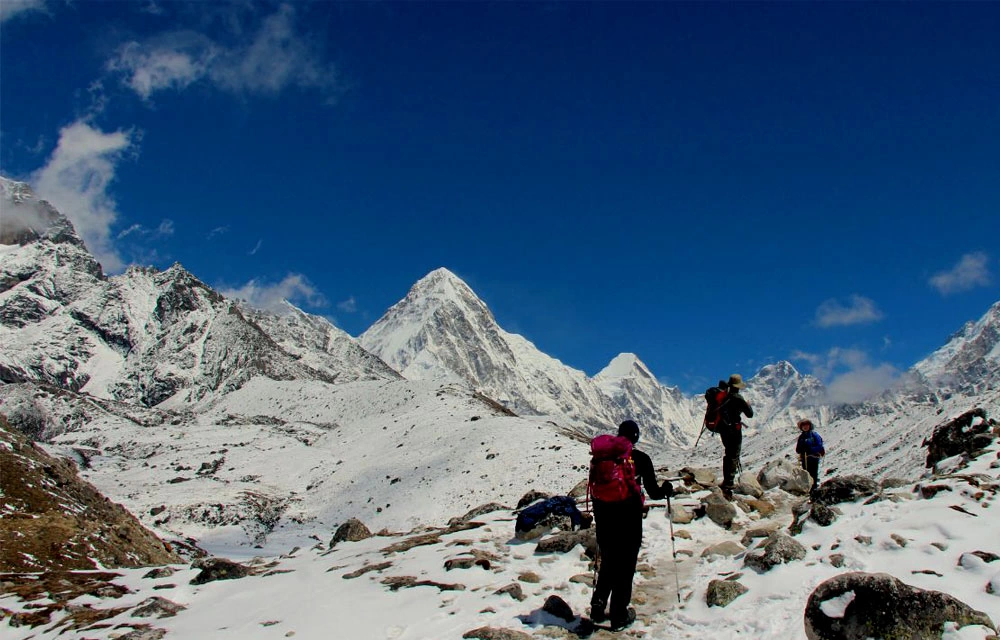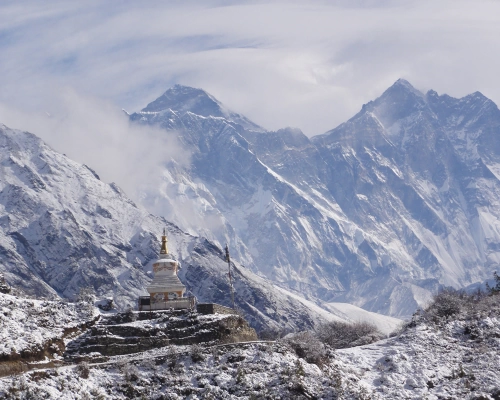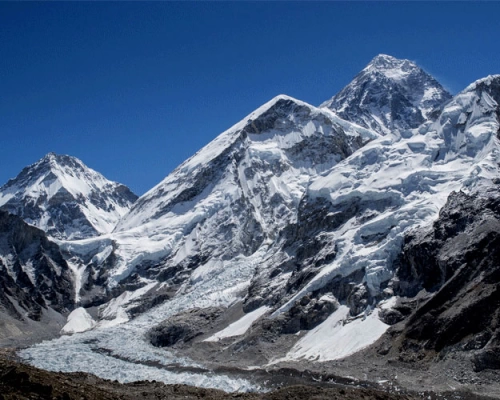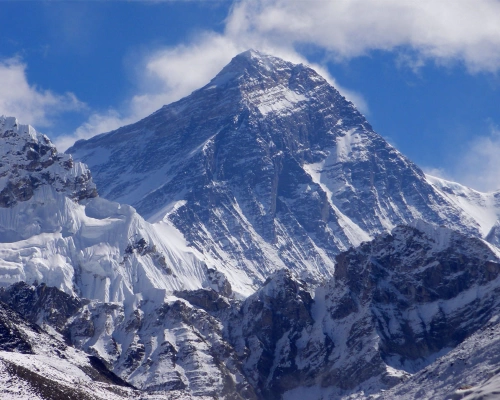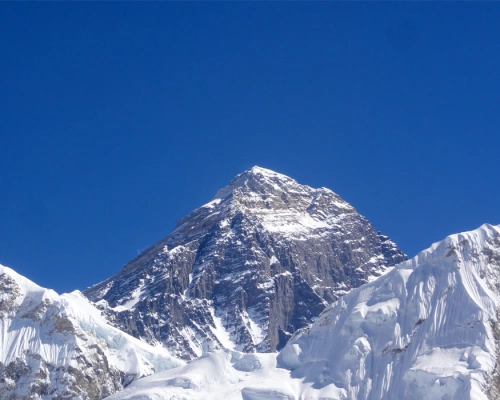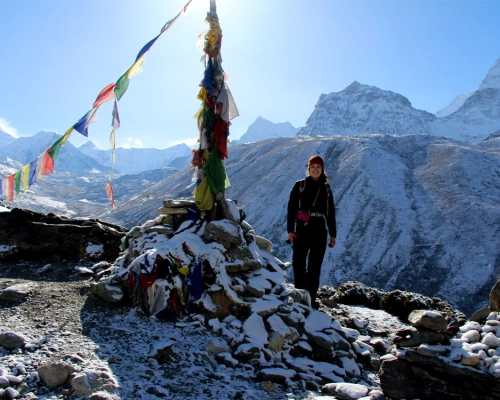- Trek through epic Everest region landmarks - Hillary Suspension Bridge, Khumbu Glacier, Everest Base Camp, Kala Patthar, and more.
- High altitude trekking and acclimatization experience inside Sagarmatha National Park amidst diverse terrain and geographic topology.
- A journey through the floral diversity of Sagarmatha National Park, with pine and hemlock forests at lower altitudes, transitioning to fir, juniper, birch, rhododendron, scrub, and alpine plant communities at higher elevations.
- Chance to spot rare wildlife such as the red panda, snow leopard, musk deer, Himalayan tahr, marten, Himalayan mouse hare, and over 118 bird species including the Impeyan pheasant, snow cock, blood pheasant, and red-billed cough.
- Experience Sherpa culture and their ways of life in the quaint local villages of Namche Bazaar, Tengboche, and Dingboche.
If you've decided to conquer the Everest Base Camp trekking trail, you likely have a special pair of shoes and a bit of a special soul.
The 14-day trek to EBC is more than just mountains and bragging rights at Everest Base Camp. Every step in Sagarmatha National Park is a step into a world where nature reigns supreme. High-altitude trekking in this UNESCO World Heritage Site offers a unique experience navigating varied terrains, from lush forests to rocky trails.
The park is also a sanctuary for a rich array of flora and fauna, including rhododendron forests that burst into color in the spring and rare wildlife like the elusive snow leopard and red panda. As you proceed higher on the Everest Trek, the air thins, and the landscape becomes more serene, the stark beauty of the alpine environment mesmerizing.
Your trip to the top of the world in the Everest region begins after a scenic mountain flight from Kathmandu to Lukla. You’ll land on a narrow airstrip and commence your actual trek. What follows is days of trekking through Everest region’s celebrated villages of Phakding, Namche, and Khumjung.
While Namche Bazaar is popular for being a commercial hub and a bustling town in one of the most rugged regions in the world, the stay at Tengboche is arguably more memorable.
In the quaint villages of Tengboche and Dingboche, you will be welcomed to a world where ancient traditions thrive amidst the high mountains.
Tengboche is home to a renowned Buddhist monastery, where the rhythmic chants of monks provide a serene backdrop to the majestic views. In these villages, the Sherpa ways of life are vividly displayed through their hospitality, vibrant festivals, and the simple yet profound connection they share with their environment.
You won't be short of things to do in your Everest Trek. Further into the 14-Day Everest Trekking Expedition, you will traverse the Khumbu Glacier with its ice formations and deep crevasses. The trek climaxes at Everest Base Camp and Kala Patthar, where you will stand with a sense of accomplishment, pride, and hopefully, a new reason to be grateful for life.
14-Day Trek to Everest Base Camp at 5,364 m (17,598 ft)
The Everest Base Camp at 5,364 meters is every trekker’s pilgrimage. Standing at the base of the world’s tallest mountain, surrounded by towering ice formations and snow-capped peaks, is an indescribable feeling.
We take scores of trekkers to base camp every season. While each has its unique trekking experience, the feeling when reaching the giant spray-painted rock at base camp is similar - a sense of accomplishment and pride.
Pride in knowing that you spent days eating and sleeping in modest teahouses, put an incredible strain on your body while listening to it, and conquered the destination with incredible mental fortitude that never wore off.
While the trek to Everest Base Camp is demanding and requires physical fitness and mental determination, it is accessible to most people with the right preparation and a positive mindset.
It’s not just ice formations and tented expedition camps at the base camp of the world’s highest peak. In the climbing seasons of spring and fall, you will see the action firsthand at base camp with tents bustling with expedition groups and preparation activities. Their determination and personal stories are inspiring, leading one to be thankful for human fortitude and the ability to explore and conquer.
Panoramic View from Kala Patthar (5,644 m/ 18,519 ft), Everest Region’s Best Viewpoint
Though not a mountain itself, with a prominence of only 10 meters (33 ft), ascending Kala Patthar is a popular activity among trekkers in the Everest region. This is because it offers the most accessible close-up view of Mount Everest.
Due to the way the Everest massif is structured, the surrounding areas (including the base camp) have a blocked view of Everest's high summit by Nuptse. This makes Kala Patthar even more special as it offers unobstructed views of Everest.
For this reason, the literal “Black Rock” has arguably become the Everest Region’s preferred vantage point.
The views of Everest, Nuptse, and Ama Dablam are spectacular from Kala Patthar. You can also see the northern flank and summit of Lhotse. Similarly, the panorama comprises Mt. Pumori, Changtse, Thamserku, and Kantega.
There’s another compelling reason to trek to Kala Patthar. The landmark’s peak is the highest point you can go to in the Everest region without a climbing permit. If you include the ascent of Kala Patthar in your Everest trek, it will also be the highest point of your trip. Perhaps for this reason, Kala Patthar is also known for making climbers out of some trekkers - because they find out the best view is from the top.
Discovering Sherpa Traditions, Culture, and Lifestyle While on Your Everest Base Camp Trekking Route
The Sherpa people, renowned for their resilience and mountaineering prowess, inhabit the villages scattered along the trekking route in the Khumbu region of Nepal.
Starting from the vibrant Namche Bazaar, a bustling Sherpa trading hub nestled amidst towering peaks, trekkers can explore local markets bustling with activity and visit ancient monasteries resonating with chants and prayers.
Further along the route, Tengboche Monastery stands as a spiritual beacon, where Sherpa monks engage in religious practices that reflect centuries-old traditions.
Throughout the journey, you will witness Sherpa festivals like Tihar and Mani Rimdu, witnessing colorful rituals, masked dances, and communal feasts that celebrate both the religious and cultural heritage of the Everest region.
Not to forget, dining experiences in Sherpa-run teahouses introduce trekkers to traditional cuisines such as hearty Sherpa stew (thukpa) and sweet Sherpa bread (khapse).
From Khunde, Khumjung, Tengboche, Pangboche, Phortse, Thame, Dingboche, and Lobuche to Gorak Shep, the journey to Mount Everest base camp reveals the heart of Sherpa culture. Along this path, you'll encounter Sherpas carrying loads with seemingly effortless grace, hear stories of their legendary climbs, and witness their deep reverence for the mountains they call home. Each village tells a tale of Sherpa's resilience, spirituality, and the enduring bond between the people and their extraordinary surroundings in Nepal’s Everest region.
How to Make the Most Out of Your Trek to Mount Everest Base Camp?
The classic Everest Base Camp trek 14 Days is a time-honored journey, renowned for its breathtaking views and the profound sense of achievement it brings to trekkers. However, there is more than one way to do it.
Whether you seek a fast-paced journey, a luxurious adventure, or an extended high-altitude challenge, there’s a perfect EBC trek for you.
Each of these trek variations offers a unique way to experience the Everest region. Depending on your preferences, time availability, and desired level of adventure, here are some exciting options to consider:
7 Days Short Trek to EBC
If you’re short on time but don’t want to miss out on the iconic trek to Everest Base Camp, the 7 Days Short EBC Trek is perfect for you. This itinerary is designed for trekkers who are fit and can handle a fast-paced adventure. You’ll experience the breathtaking landscapes and rich Sherpa culture, covering the essential highlights in a condensed time frame. While challenging, it offers a rewarding sense of accomplishment.
Everest Base Camp Trek with Helicopter Return
For those looking to combine the thrill of trekking with the luxury of a swift return, the Everest Base Camp Trek with Helicopter Return is an ideal choice. You’ll trek up to EBC, soaking in the stunning vistas and serene atmosphere, and then enjoy a scenic helicopter flight back to Lukla, and then to Kathmandu. This option saves time and offers an unforgettable aerial view of the Himalayas, including Everest itself.
Sleep at Everest Base Camp Trek - Stay Overnight at EBC
Experience the ultimate adventure by opting for the Sleep at Everest Base Camp Trek. This unique variation allows you to stay overnight at EBC, giving you the rare opportunity to witness the mesmerizing starry night sky at the base of the world’s highest peak. It’s an incredible way to immerse yourself in the rugged beauty of the region, offering a more intimate and profound connection with the mountain.
Luxury Everest Base Camp Trek
For those who desire comfort, convenience, and adventure, the Luxury Everest Base Camp Trek is the perfect option. This trek ensures you enjoy the journey with premium services including heli transport, high-end lodges, gourmet meals, and personalized attention. You’ll experience the best of both worlds – the raw beauty of the Khumbu region and the luxury of top-notch facilities.
Everest Three High Pass Trek
The Everest Three High Pass Trek is designed for the adventurous soul seeking a more challenging and comprehensive experience. Apart from the base camp and Kala Patthar, this trek takes you through three high mountain passes – Renjo La, Cho La, and Kongma La – offering unparalleled views and an immersive exploration of the Everest region.
Why Trek to EBC with Sublime Trails
Our team at Sublime Trails hopes you remember the experience of sharing stories over a cup of butter tea just as much as you cherish sunrise at Kala Patthar or trailblazing the Everest trekking trail.
Here’s why you should choose Sublime Trails for your EBC Trek:
Experienced Local Guides
We pride ourselves on our team of expert local guides. Our guides are all licensed and have years of experience trekking in the Everest region. They will be able to help you navigate the trails safely and enjoy the experience to the fullest.
Variety of Trek Options
Aside from this classic 14-day Everest trek, we offer a variety of trek options to EBC, from short EBC treks to Everest luxury treks.
This means that you can find a trek that fits your fitness level and budget. If you’re trekking in a private group, you can also customize the itinerary, whether you want to spend more days at Tengboche or take a detour somewhere.
Comfortable Accommodation
Our trip planners select the best accommodation options for every night in the Everest region. Whether for your first night in Phakding or further up in Dingboche, our guides know beforehand the availability and quality of services in teahouses.
After all, nothing beats a warm bed and a delicious meal at the end of each trekking day.
Sherpa Cultural Experience
Trekking to EBC is more than just mountains and the base camp. You will get to see traditional Sherpa villages, meet the Sherpa people, and learn about their way of life. Sublime Trails can help you to arrange visits to local monasteries and other cultural sites.
More than what you asked for
We also offer these benefits:
Airport transfers
We will take care of getting you from the airport to your hotel in Kathmandu and back again.
Permits and paperwork
We will take care of all of the necessary permits and paperwork for your trek so you don’t have to, especially in a country where government work is not as streamlined.
Equipment
Ideally, we’d want you to buy nothing for the trek. While we can’t do that completely, we do provide trekkers with what we can for the Everest trip. You will get return-after-use sleeping bags, rain ponchos, duffel bags, other gear, and goodies depending on their availability at our office store.
With all these services and our experienced local guides, your trek to Mt. Everest Base Camp will be an unforgettable adventure.


